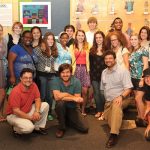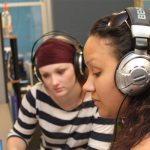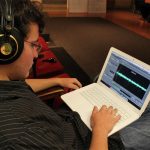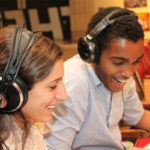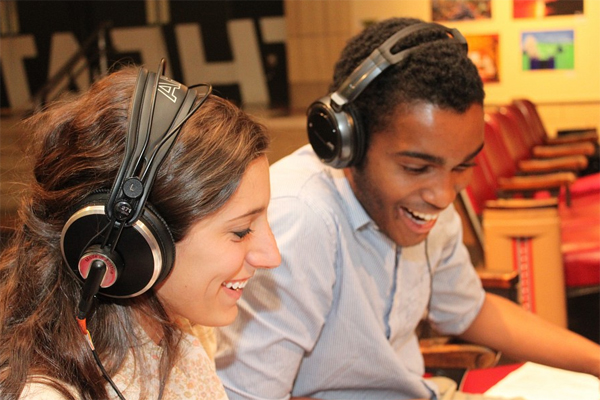
Making meaning and media from community involvement: Heinz Endowments’ Philanthropy Interns
Brian Gaudio made his first trip to the Dominican Republic with a charitable group when he was a student at Upper St. Clair High School.
“It was far different from anything I’ve experienced,” Gaudio says. Noticing that some of the kids he met lacked shoes, he started collecting and distributing gently used footwear, dubbing his project ShoeManity. He wanted to help complete schoolkids’ uniforms, and to prevent health problems.
“I guess we were young, naïve high-school kids and we wanted to do something to change people’s lives,” he says today.
It took him a few years and repeated trips south to realize that helping others wasn’t such a simple task. During his first trip, the group had handed out rice, beans and clothing to random people on the street. “If you did that on the street in the United States, you’d get a lot of strange looks, and it wouldn’t be sensitive,” Gaudio says.
As for his shoe-distribution efforts: “When you get down there and you realize there are more people who need shoes than you have, and you assume that the shoes are getting to the right people,” but they aren’t, it changes your views of how philanthropy could and should be done.
“Handouts … it’s not really solving any problems, it’s creating problems,” he says today. “It’s creating a stigma that we don’t want to create. We’ve learned a lot from the mistakes we made.”
And a lot from his time as an intern with the Heinz Endowments Summer Youth Philanthropy Internship Program, which he joined after his senior year of high school, in the summer of 2009.
The Heinz program takes students between high school and college, teams them with each other and a local nonprofit agency, and aims to make them fledgling philanthropists. It teaches them to focus on important community issues, seek sustainable solutions and find the right partners who are capable of work worthy of $25,000 grants. The program also teaches them wise use of the media, partnering with radio programs Saturday Light Brigadeand the Allegheny Front to train them to make short audio documentaries (broadcast on SLB and featured here), and with Pittsburgh Filmmakers for the production of short videos. These media experiences also teach interns to learn about the world by talking directly to people affected by each issue.
Gaudio’s team, for instance, spent his initial internship focused on Pittsburgh park restoration. He joined the program for a second summer as a senior intern – a kind of supervisory role – and oversaw a team focused on local storm-water management.
Now a student at North Carolina State University, he has taken his Heinz lessons back to the Dominican Republic village of Las Lajas – to interview residents.
“The most important thing that we can do is to go in with an open mind and a hunger to learn about the culture and people,” he says. “It’s more about having humility: ‘We don’t know anything about your culture, we don’t belong, so let’s educate people in the United States.’”
What did these Dominican kids actually want? To paint a mural on their school. And they were eager to document the process, using videocameras Gaudio and his fellow N.C. State students had brought. Gaudio’s group – now called Que Lo Que, after the local greeting – left the kids with a burned DVD of their documentary to play on the village’s sole DVD player.
The program taught other lessons, he adds. “One thing I took from it is that Pittsburgh is a great city and there are a lot of great projects and great communities I wouldn’t have known about. A lot of my friends at N.C. State, they’re annoyed: ‘You can only reference Pittsburgh once a day, Brian.’”
Wayne Jones, a program officer in Children, Youth & Families at the Heinz Endowments, is very pleased that the program helps kids find their voices. “We probably won’t know the true impact for years,” as each intern becomes a young adult, Jones says. “But what I’ve seen so far is really encouraging and inspiring. They feel more interested in volunteering and working to make the community better.”
Abbie Ferry graduated from Franklin Regional High School in 2010. Her intern team, working with the United Way, focused on improving parks and playgrounds to keep violence and drugs away.
“The day we prepared our project, there was a shooting in a North Side playground,” Ferry recalls. They found a local group and leader to take ownership of the Third Street Playground in McKees Rocks. Now, in 2011, that work has been doubly rewarded with a $75,000 from KaBOOM!.
“That was really a great success for us, because we had granted the money [in 2010], hoping they could build on it,” says Ferry. “It was great to see that someone else saw the potential and put faith in it and money in it.”
She was also amazed at the results her group got from interviewing kids on North Side streets. “’People got shot there.’ ‘I see drug deals,’” the children told her about their parks. “Kids understand more than we give them credit for. To hear those young kids speak out, it was really powerful.”
This past summer, when she returned as a senior intern, she tried her own radio piece on the impact of the state’s education budget cuts. Again, the reactions of local kids impressed her: “They almost understood it on a deeper level than a lot of the legislators do.”
Jeff Baron, who until recently was the long-time director of education and outreach for?SLB Radio Productions, has seen three years of Heinz interns through their radio productions.
“It was almost easier for them to get their stories across in radio because it’s simpler” than video, Baron says. “I think they got a lot out of what we taught them” – everything from objectivity to scripting the narration of their three minute-long pieces. “That was a huge challenge for them. They had to make crucial decisions.”
“They don’t realize how much work it is,” says Susan Howard, director of Filmmakers at the Center for the Arts, who saw the interns through their video-making experience. “All students today now encounter some component of media creation, but I think they come away with much more appreciation of what it takes to go into something that is a more well-rounded, more well-researched piece. They gain a new understanding of how they look at media, how they perceive the news, how they perceive documentaries in general.”
“This is the age of 24/7 sensationalized news,” Baron adds. “It’s great to teach them about ethics that may have disappeared. Maybe we can look forward to a whole new crop of journalists, old-school style.”
Hannah Trivilino, a 2011 graduate of Mt. Lebanon High School, was a Heinz intern this summer. Her team worked with Adagio Health and focused on the medical and social impact of STDs.
“I learned a lot about money – what it can achieve, and how hard it was to give away,” she says. Her group found it difficult to attract a grant applicant who wanted to work toward their twin goals of screening young people for STDs and creating an educational program about the risks. They finally funded a program at Washington and Jefferson College. The group’s media documentaries highlighted the social impact of Marcellus Shale drilling on local towns.
Today, Trivilino is a student at Macalester College in St. Paul, Minnesota, where she volunteers with a health-focused club.
“I learned about so many awesome nonprofit organizations that are doing work in the city,” she says of her Heinz experience. “It made me wish I had more time to work with these groups.”
The program has “continuing ripple effects,” concludes Wayne Jones. Last year, for instance, Strong Women, Strong Girls received a grant from a Heinz intern team to educate girls about the health hazards of some personal-care products. With that grant, SWSG participants made and marketed their own safe products, donating the proceeds to other nonprofits and creating their own video about this effort. The video was recently one of only seven winners (out of 4,500 hopefuls) in the Youth Service Challenge program of the Jefferson Awards.
“The connections we were able to make with the community, with each other, with the professional world, were just invaluable,” adds Abbie Ferry. “You put five people together in a room who could not be more different from each other – you’d be amazed at the similarities. I have these connections that will serve me as long as I need them to.”
